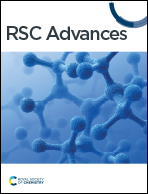Porous acid–base hybrid polymers for enhanced NH3 uptake with assistance from cooperative hydrogen bonds†
Abstract
Carboxylic acid-modified materials are a common means of achieving efficient NH3 adsorption. In this study, we report that improved NH3 adsorption capacity and easier desorption can be achieved through the introduction of substances containing Lewis basic groups into carboxylic acid-modified materials. Easily synthesized mesoporous acid–base hybrid polymers were constructed with polymers rich in carboxylic acid and Lewis base moieties through cooperative hydrogen bonding interactions (CHBs). The hybrid polymer PAA–P4VP presented higher NH3 capacity (18.2 mmol g−1 at 298 K and 1 bar NH3 pressure) than PAA (6.0 mmol g−1) through the acid–base reaction and the assistance from CHBs with NH3, while the NH3 desorption from PAA–P4VP was easier for the reformation of CHBs. Based on the introduction of CHBs, a series of mesoporous acid–base hybrid polymers was synthesized with NH3 adsorption capacity of 15.8–19.3 mmol g−1 and high selectivity of NH3 over CO2 (SNH3/CO2 = 25.4–56.3) and N2 (SNH3/N2 = 254–1068), and the possible co-existing gases, such as SO2, had a lower effect on NH3 uptake by hybrid polymers. Overall, the hybrid polymers present efficient NH3 adsorption owing to the abundant acidic moieties and CHBs, while the concomitant Lewis bases promote NH3 desorption.



 Please wait while we load your content...
Please wait while we load your content...